Is Scuba Diving An Extreme Sport?
Online Feb 20, 2024
You might question this, especially if you’ve only experienced it on a calm, tropical vacation.
Yet, when you look closer, you’ll find a deeper, more thrilling dimension to this underwater activity that qualifies it as an extreme sport.
With the right precautions, you can navigate the risks and enjoy the ultimate thrill that extreme scuba diving offers.
So, buckle up and get ready to dive into the fascinating world of extreme scuba diving.
It’s not just a sport; it’s an adventure that pushes boundaries and tests your limits.
Is scuba diving a sport?

You might be wondering, is scuba diving really a sport?
Considering the physical exertion, risks, and specialized gear involved, especially in extreme forms like shark diving or wreck diving, it’s clear that scuba diving goes beyond being just a leisure activity.
Like traditional sports, Scuba diving requires strength, stamina, and agility. Furthermore, the benefits of scuba diving, such as improved fitness, mental calmness, and the thrill of exploration, make it more than a hobby.
But how does scuba diving stack up against traditional sports?
Like football or basketball, scuba diving demands skill, discipline, and a keen understanding of the environment. However, it carries an element of unpredictability – the underwater world is not a controlled environment, adding an extra layer of excitement and challenge.
You can enjoy scuba diving as a recreational activity, leisurely exploring coral reefs and marine life. But push it to the limits – think drift diving, night diving, even cave diving – and it becomes an adrenaline-pumping extreme sport.
So, whether a sport or not, scuba diving offers an exhilarating experience.
What qualifies as ‘extreme’?
Think of it like being a daredevil in the wild west, where every move is filled with adrenaline and danger; that characterizes an adrenaline-charged activity.
An extreme sport, like scuba diving, is a high-risk activity where the thrill of the danger is often as much a part of the attraction as the sport itself.
Compared to other extreme sports, such as BMX racing or ice climbing, scuba diving might seem less intense, but don’t be fooled.
The risks involved, from equipment failure to unpredictable marine life, can turn your underwater adventure into a life-threatening situation.
The physical demands of scuba diving also make it an extreme sport. It isn’t simply about leisurely swimming underwater.
You’re controlling your buoyancy, managing your oxygen supply, and navigating currents while carrying heavy equipment. This requires physical fitness, agility, and a high level of focus.
Remember, while extreme sports offer excitement and a break from routine, they also demand respect for the risks involved. Each dive you undertake should be treated with the same care and planning as a daredevil stunt. That’s the true spirit of an extreme sport.
Death statistics
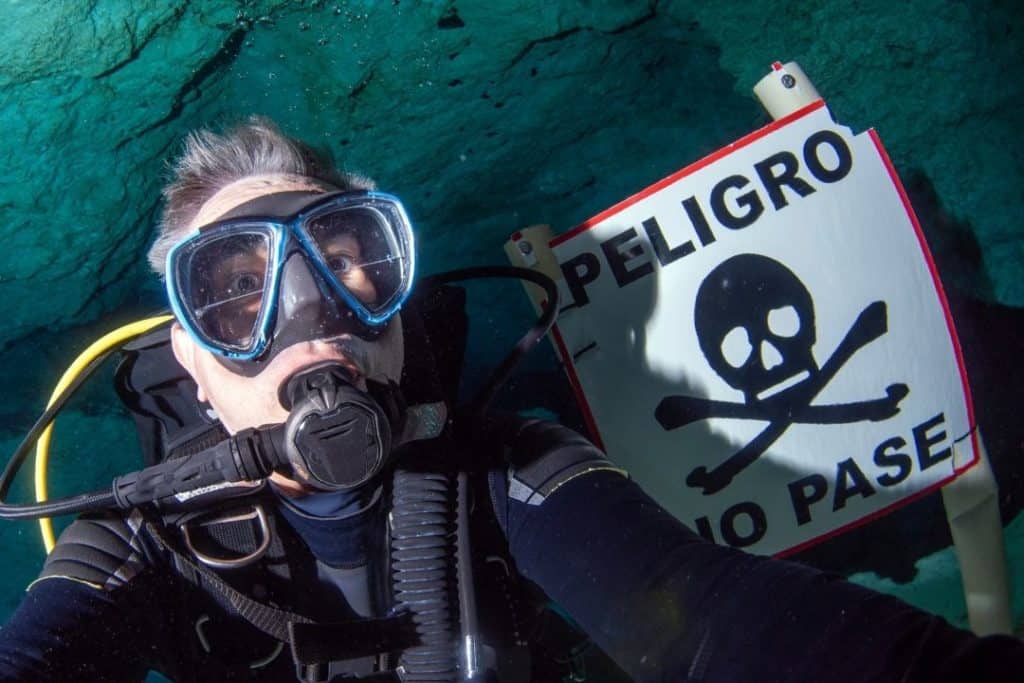
According to the United States Parachuting Association (USPA) and Divers Alert Network (DAN), the fatality rates for skydiving and scuba diving are relatively low, which may challenge the categorization of scuba diving as an extreme sport.
- In the case of skydiving, the death rate is calculated per jump, with an average of 100 jumps per member per year, and 21 deaths among 32,000 members. This measurement yields a significantly higher death rate if calculated per skydiver, rather than per jump.
- Similarly, for scuba diving, fatalities are calculated per diver rather than per dive. The report indicates an annual fatality rate of 16.4 per 100,000 divers. This rate, extrapolated to the estimated 3 million divers in the US, would imply around 492 deaths per year – a figure high enough to question the safety of the sport.
How does scuba diving compare to other extreme sports?
Dare to compare the statistics, and it’s clear that this underwater adventure holds its own against other high-risk activities
As you delve into extreme scuba diving, you’ll find that the challenges are comparable to those in other extreme sports.
The adrenaline rush of diving deep into the ocean, exploring hidden caves, or gracefully drifting along a powerful current can equal the thrill of BMX racing, slacklining, or ice climbing.
The safety measures in extreme scuba diving are of paramount importance.
It’s not just about strapping on a tank and plunging into the deep blue. It requires an in-depth understanding of the equipment, respect for the underwater environment, and rigorous training.
Like in other extreme sports, your safety hinges on your ability to control and manage risks.
The statistics are compelling. After all, it’s not every day you get to share your playground with sharks, navigate through sunken wrecks, or break through the surface of a frozen lake.
Extreme scuba diving is more than just a leisure activity—it’s a test of your limits, a conquest of the unknown. It demands respect, skill, and a sense of adventure, just like any other extreme sport.
The most extreme types of scuba diving
You’re about to dive into the thrilling world of extreme scuba diving. Imagine exploring submerged caves, drifting effortlessly with the current, or examining historic shipwrecks at the ocean’s depths.
Whether you’re a professional diver or an adrenaline junkie, technical diving, cave diving, and wreck diving are a few ways you can take your scuba experience to the next level.
Cave diving
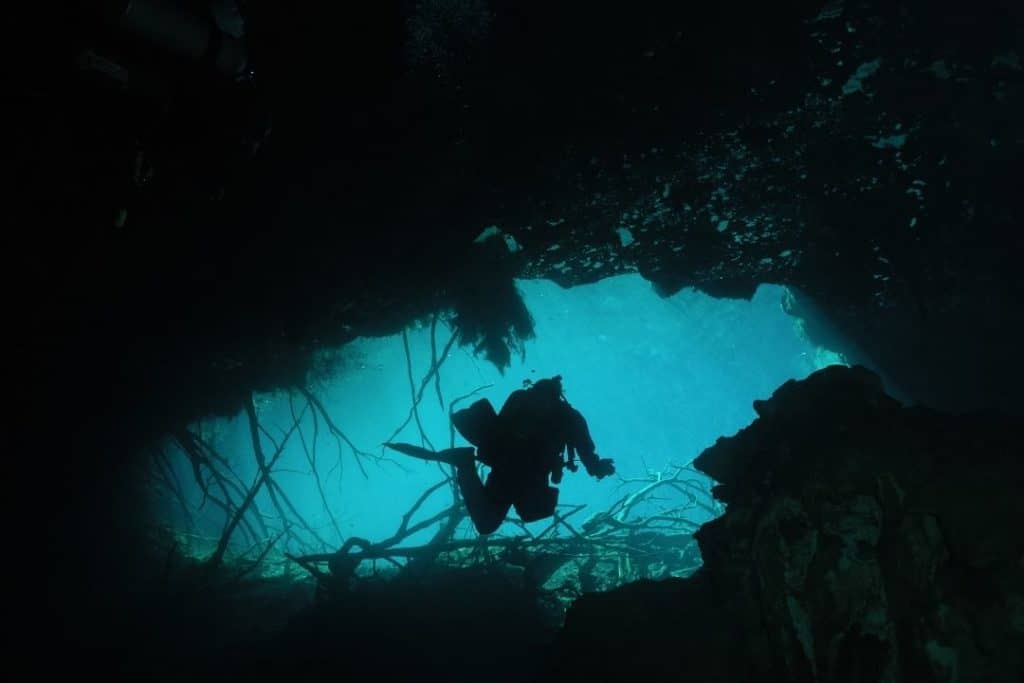
Cave diving calls for courage, combining the complexities of technical diving with the added challenge of navigating an overhead environment.
You’ll need top-notch equipment, including a primary and backup light, a safety reel, and a guideline.
Remember, quality tools are your lifeline in underwater caves’ murky depths and tight corners.
Safety measures are paramount. Never dive beyond your light range, and always maintain a line to open water.
This isn’t a sport you can jump into, buddy. Intensive training is required to handle the demanding conditions and potential hazards. But with the right preparation, you can experience the awe-inspiring beauty of underwater caves.
Remember, control is key. Keep your cool and respect the cave environment.
Wreck diving

Moving on from the thrill of cave diving, let’s delve into the intriguing world of wreck diving. This type of diving isn’t for the faint-hearted.
The risks in wreck diving, such as silt-out, entanglement, or entrapment, make it an extreme sport that demands your respect and preparedness.
You must equip yourself with the right gear and a solid understanding of the hazards. Famous wreck diving sites like the Titanic and the USS Arizona serve as a reminder of the past, adding a historical element to this underwater adventure.
Don’t underestimate the demands of wreck diving. It’s an extreme sport that requires mental strength, physical endurance, and a deep respect for the power of the ocean.
Technical diving
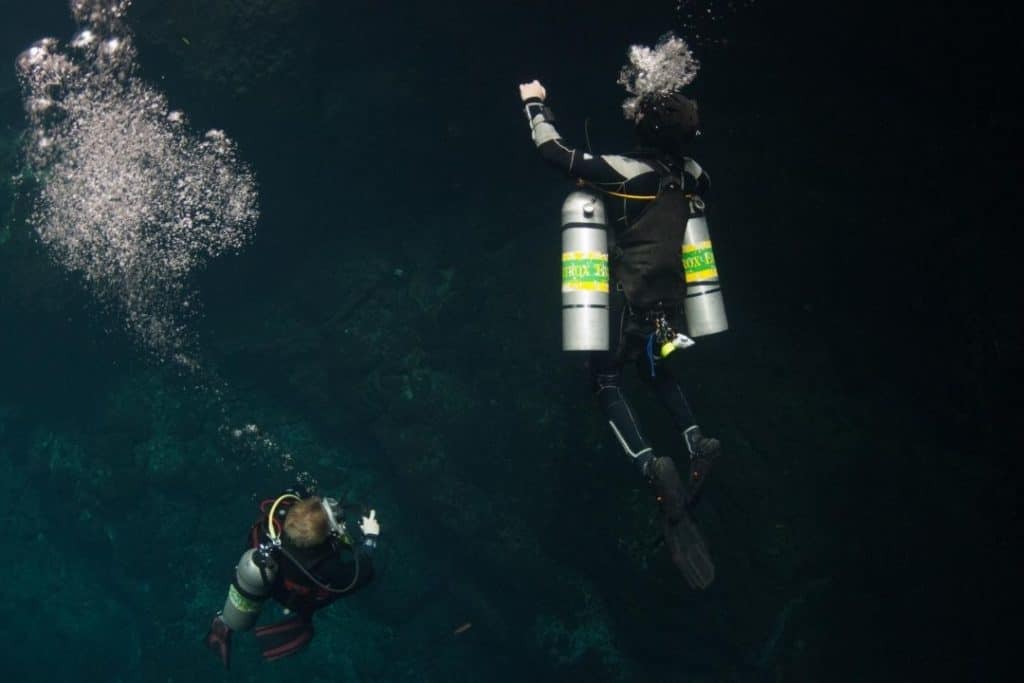
Plunging into the depths beyond the limits of recreational levels, that’s where technical diving takes you , it requires additional equipment, more advanced training, and meticulous planning.
It’s not for the faint of heart but for those who crave control and the thrill of deep-sea exploration.
The technical diving risks are real. The deeper you go, the more risks you’ll encounter like decompression sickness, nitrogen narcosis, and oxygen toxicity.
But with the right advanced scuba equipment and preparation, you can mitigate these risks.
Double tanks, dive computers, and specialized gas mixes are your allies in this extreme sport.
Embrace the risks and rewards of technical diving. It’s more than just an adventure, it’s a test of your skills and your command over the underwater world.
Professional divers
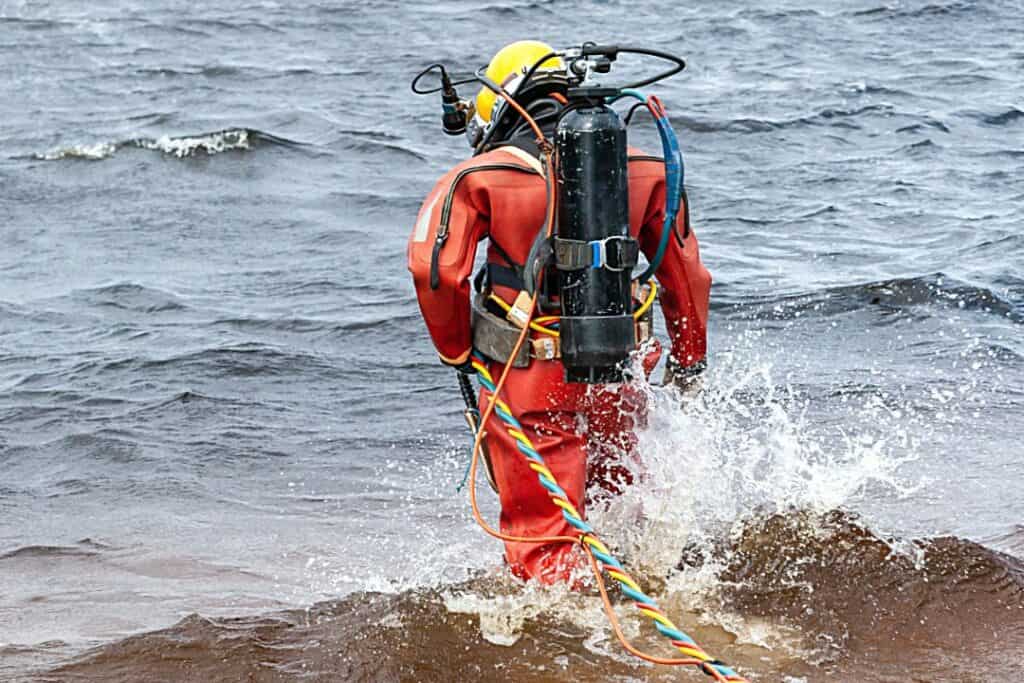
After learning about the intricacies of technical diving, it’s clear that this isn’t a casual hobby.
Now, let’s shift our focus to professional divers. They don’t just dive for thrills, but they’ve transformed their passion into a career.
It’s not all fun and games, though. These pros undergo rigorous professional training to become masters of their craft.
They learn the ins and outs of safety precautions to manage the inherent risks. Moreover, their physical fitness is top-notch, as diving requires strength, flexibility, and endurance. They’re not just athletes; they’re professionals in an extreme sport.
Remember, whether you dive for fun or professionally, the same principles apply: Train hard, dive safe, and respect the ocean.
Drift dives
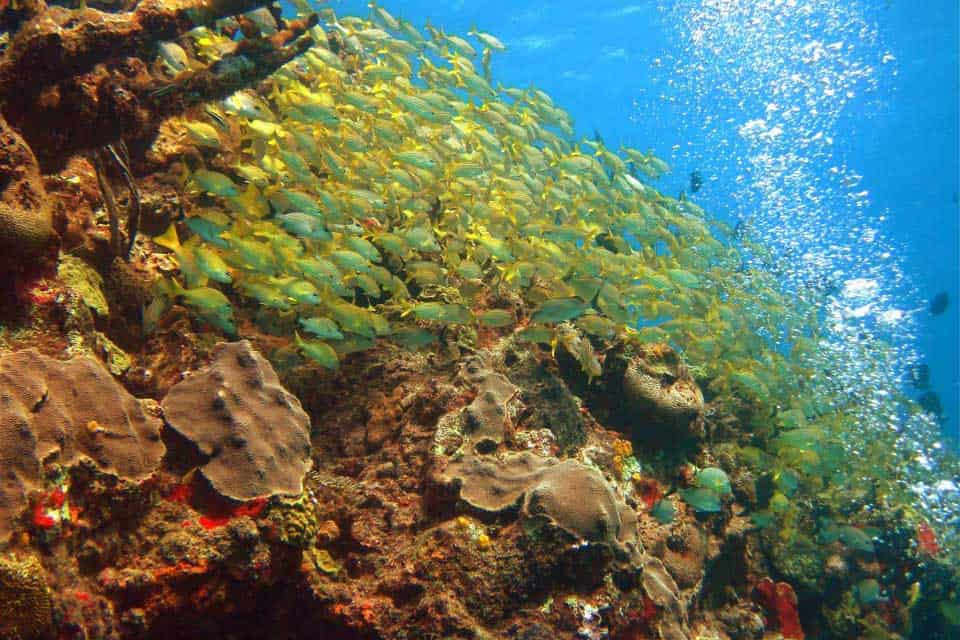
With a penchant for thrill, let’s delve into the adrenaline-fueled world of drift dives, where you’re at the mercy of the ocean’s current, turning you into an underwater free-flier.
Mastering drift dive techniques, you’ll glide with the flow, exploring vast underwater landscapes. You’ll need specific equipment for drift diving.
A reliable dive computer, a surface marker buoy, and perhaps a reef hook to maintain position in stronger currents.
Safety precautions in drift diving are paramount. Always dive with a buddy and communicate your plan.
Stay alert to changes in the current’s strength and direction. Remember, you’re not fighting the ocean, but dancing with it.
Night diving

Ever dreamt of seeing the underwater world bathed in a whole new light? Night dives may just be your ticket to that surreal experience.
This is no ordinary dive, mind you. It’s an adventure that requires careful planning and stringent safety precautions.
You’ll need to master underwater navigation to make your way in the dark.
And it’s not just about seeing things differently; it’s about experiencing marine life encounters that are unique to the night. Creatures that hide during the day come out to play, providing you with sights you won’t easily forget.
Remember, your safety is paramount. Make sure you’re comfortable in the water, follow your training, and respect the underwater world.
Now, are you ready for a nocturnal dive into the deep?
Conclusion
So, you’ve seen how scuba diving can indeed be categorized as an extreme sport, especially when it involves challenging elements like shark diving, night diving, drift diving, wreck diving, technical diving, ice diving, and cave diving. Let’s break it down further.
Each of these activities has its own set of pros and cons. Shark diving offers exhilarating encounters with these majestic creatures, but it also requires a high level of caution.
Night diving opens up a whole new underwater world, yet necessitates advanced navigation skills.
Drift, wreck, and technical diving can give you an adrenaline rush, but they come with risks like entanglement and silt-out.
Ice and cave diving demand a strong team dynamic, proper equipment, and rigorous safety precautions due to their inhospitable environments.
You must recognize that this sport isn’t for those afraid of taking risks or putting in the effort to get properly trained. Extreme scuba diving requires specialized gear, meticulous planning, and an absolute respect for the environment.
As long as you’re ready, the thrilling world of extreme scuba diving awaits. Remember, the key to conquering the depths lies in your preparation, courage, and respect for the sea’s inhabitants.
Conclusion
So, is scuba diving an extreme sport?
Absolutely! With its adrenaline-pumping scenarios, specialized gear, and the sheer skill required, it’s no less extreme than any other adventure sport.
But remember, it’s all about enjoying the thrill while respecting the sea. Isn’t that what makes an extreme sport worth the risk, after all?

